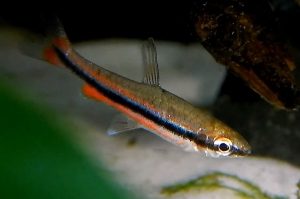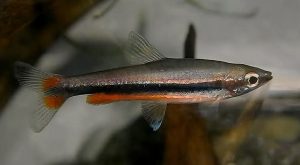The Golden Pencilfish (Nannostomus beckfordi) is also known to tropical fish keeping enthusiasts as Beckford’s Pencilfish or Brown Pencilfish.
The Golden Pencilfish has a long, elongated body that is gold with a silvery band along the middle of the flanks, bordered above by a reddish band, and below by a blackish band with a cream to white underbelly.
It possesses a black spot on the lower half of it’s gill covers and has a red caudal fin. Males have an enlarged, well developed anal fin which is used in courtship and spawning, and like most Nannostomus species, the Golden Pencilfish acquires a vertically barred colour pattern at night.
Adult males are more intensely colored and have a curved posterior anal fin, which is straight in the females. Females are less colorful and noticeably more round bodied than the males.
Golden Pencilfish are widely distributed throughout the rivers of Guyana, French Guiana, Suriname, and the eastern Amazon drainage in Amapá and Pará states, Brazil. It is also found from the rio Madeira, in the lower and middle Amazon, upstream to the lower rio Negro and rio Orinoco in Venezuela.
The Golden Pencilfish is normally found in swampy areas, small slow moving rivers, and sluggish river tributaries that are densely vegetated with aquatic plants and have an abundance of leaf litter and submerged bogwood and branches.
Across their natural range, the Golden Pencilfish also exists in a number of different color forms which were once believed to be separate distinct species. Depending on their origin, they can vary wildly in color and pattern. Those listed below are now considered synonymous with Nannostomus beckfordi.
- Nannostomus beckfordi surinami collected from Berg en Dal, just north of Brokopondo reservoir, in Suriname.
- Nannostomus anomalus collected in the middle Amazon close to Santarém. In these specimens the upper part of the body is brownish, the lower part yellowish, and the dark lateral stripe does not reach the caudal fin. It is edged above and below by narrow silver stripes.
- Nannostomus simplex from Lama Stop off, in Guyana has a dark gray dorsal surface with a dark median line. It has a light band from the snout to the base of the upper rays in the middle of the caudal fin, a black band through it’s snout to the base of it’s lower caudal fin through the two middle rays. Except for a spot between the tips of the ventral fins, the ventral surfaces are plain. Chromatophores of the lateral band are scattered above the pectoral fins and in front of the anal fin.
- Nannostomus aripirangensis from Arapiranga Island, close to Belém, Pará state, in Brazil appears to be the form most commonly found in the aquarium hobby. It’s base body color is a dark brown, with a dark lateral band that extends into the central caudal fin rays. The rest of the caudal fin base is reddish, as are the ventral fins that are tipped white to a light blue color.
The Golden Pencilfish should ideally be housed in a densely planted 15 gallon or larger aquarium with a dark, sandy or fine gravel substrate, some floating plants to diffuse lighting, a few pieces of driftwood
or bogwood, and some dried Indian Almond Leaves
or leaf litter on the bottom of the tank.
Dried Indian Almond Leaves establish colonies of beneficial microbes as they decay which provides a secondary food source to the fish. The decomposition also releases tannins and other chemicals into the water that keeps the fish healthy.
Golden Pencilfish are a slow moving, relatively peaceful species that do best with at least 10 or more of their own kind in a biotope setting. They can be housed in a community tank environment with similarly sized rasboras, anabantoids, tetras, barbs, dwarf cichlids, callichthyid or loricariid catfishes, but they will not compete with larger or boisterous tankmates.
A corner air powered sponge filter is all that is necessary for keeping pencilfish. They do not do well in strong currents.
Golden Pencilfish are egg scattering free spawners that do not care after their young. Adults in a mature aquarium often spawn without any outside intervention and in a densely planted tank, some fry will appear and may actually survive.
If you plan on breeding numbers of pencilfish, start by conditioning a large group with live plenty of live foods. When the fish are conditioned, select single pair, or a group of one or two males and several females.
Place them in a small breeding tank with mature water and plenty of fine leaved plants like Taxiphyllum, spawning mops, or a plastic grass matting that is often used for egg scatterers. Some breeders line the bottom of a bare tank with marbles that allow the eggs to fall to the bottom but prevent the parents from getting to the egss.
Keep the tank dimly lit, the water slightly acidic to neutral, and the temperature at the high end of their range. Provide a small sponge air filter into the tank for circulation and the spawning should commence.
After spawning occurs, (usually within 2 to 3 days) remove the parents from the breeding tank and introduce Paramecium or green water into the tank. The fry should be free swimming in about 3 days. When the fry are large enough, feed them finely crushed flake food, microworms, or newly hatched brine shrimp.
The Golden Pencilfish is a micropredator that feeds on zooplankton, minute worms, and tiny invertebrates in their natural habitat. In an aquarium environment, they can be fed a quality dried crushed flake but should be offered daily portions of live, frozen, or freeze dried brine shrimp, daphnia, Moina, tubifex, or grindal worms
.
Although wild Nannostomus beckfordi are exported on a regular basis, most specimens available to tropical fish keeping enthusiasts are commercially farmed. Golden Pencilfish are usually available online or in tropical fish keeping shops when they are 3/4″ to 1-1/4″ in size.
Minimum Tank Size: 15 gallons
Care Level: Moderate
Temperament: Peaceful
Hardiness: Moderately Hardy
Water Conditions: 69-80° F, 18 – 268 ppm, pH 5.0-8.0
Max. Size: 1.50″
Color Form: Gold, Black
Diet: Omnivore
Compatibility: Single species tank
Origin: Guyana
Family: Lebiasinidae
Lifespan: 3-5 years
Aquarist Experience Level: Beginner




